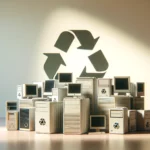In-depth: Materials Recovery in Computer Recycling
Safe and sustainable disposal of End-of-Life (EOL) electronic waste is a major concern due to its hazardous and toxic constituents. Recycling and recovering valuable and rare metals from obsolete electronics have become a lucrative business opportunity globally. The United Nations estimates that approximately 50 million tons of e-waste were produced worldwide in 2012, with the United Kingdom generating 1.3 million tons. Recycling electronics for materials recovery has the potential to reduce environmental pollution and conserve natural resources.
Key Takeaways
- Electronic waste disposal is a pressing issue due to its hazardous nature.
- Recycling electronics for materials recovery helps reduce environmental pollution and conserve natural resources.
- Computer recycling plays a crucial role in achieving a more eco-friendly and sustainable approach to waste management.
- Responsible electronics recycling is essential for mitigating the negative impact of e-waste on the environment.
- Sustainable material recovery from e-waste contributes to the circular economy and reduces the need for resource extraction.
The Impact of E-Waste Production
The production of e-waste has been increasing rapidly due to technological advancements and shorter product life cycles. The world currently produces 40-50 million tons of e-waste annually, and this number is expected to continue growing. E-waste includes a wide range of electronic devices, and improper management of e-waste can lead to environmental pollution and health hazards. Implementing waste reduction solutions and responsible recycling practices are crucial for mitigating the negative impact of e-waste.
E-waste production poses significant challenges in terms of waste management and environmental sustainability. The improper disposal and accumulation of electronic waste result in the release of hazardous substances into the environment, posing risks to both ecosystems and human health. To address this issue, it is essential to implement waste reduction strategies that focus on minimizing the generation of electronic waste in the first place.
By adopting eco-friendly practices and promoting responsible electronics recycling, we can reduce the environmental impact of e-waste production. This includes encouraging consumers to extend the lifespan of their electronic devices through repair and upgrade programs, as well as implementing effective collection and recycling systems that ensure proper handling and disposal of end-of-life electronics. Additionally, businesses and manufacturers can play a crucial role in designing products with longer lifespans and easily recyclable components, contributing to a more sustainable electronic waste management system.
| Environmental Impact of E-Waste Production | Waste Reduction Solutions |
|---|---|
| Release of hazardous substances | Promoting repair and upgrade programs |
| Pollution of ecosystems | Implementing effective collection systems |
| Health hazards for humans | Proper handling and disposal of e-waste |
| Depletion of natural resources | Designing products with longer lifespans |
Efforts to reduce e-waste production and promote responsible recycling can lead to significant environmental benefits. By minimizing the amount of electronic waste generated, we can conserve natural resources, reduce greenhouse gas emissions associated with resource extraction and manufacturing, and prevent the release of hazardous substances into the environment. Waste reduction solutions also have the potential to create a more circular economy, where valuable materials are recovered and reused, reducing the need for new resource extraction.
The Value of Recoverable Materials in E-Waste
E-waste contains a wealth of valuable resources that can be recovered through recycling, contributing to sustainable material recovery and reducing the need for new resource extraction. These resources include both base metals and precious metals, making e-waste a treasure trove of reusable materials.
Base metals such as copper, tin, and iron are commonly found in electronic waste. These metals have various industrial applications and can be recycled and reused in the production of new electronic devices. By recovering base metals from e-waste, we can conserve natural resources and reduce the environmental impact of mining operations.
Additionally, e-waste contains precious metals like gold, silver, platinum, and palladium. These metals have high intrinsic value and are widely used in electronic components, particularly in circuit boards and connectors. Recycling e-waste allows us to extract these precious metals and reintroduce them into the manufacturing process, reducing the need for costly and environmentally damaging mining.
| Material | Estimated Value (in billions of euros) |
|---|---|
| Base Metals | 50 |
| Precious Metals | 5 |
According to a study, the value of raw materials in e-waste was approximately 55 billion euros in 2016. This highlights the enormous potential for economic and environmental benefits that can be derived from sustainable e-waste recycling and material recovery.
The Importance of Sustainable Material Recovery
Sustainable material recovery from e-waste not only reduces environmental pollution but also conserves valuable resources and contributes to a more circular economy.
By responsibly recycling e-waste and recovering valuable materials, we can minimize the extraction of new resources and reduce the environmental impact associated with mining, such as soil erosion and water contamination. Furthermore, sustainable material recovery from e-waste promotes the efficient use of resources and reduces the overall carbon footprint of the electronics industry.
Implementing efficient and ethical e-waste recycling practices is crucial for realizing the full potential of valuable resources in electronic waste. It requires collaboration between producers, governments, and consumers to ensure that e-waste is properly collected, processed, and recycled. Through sustainable material recovery, we can transform e-waste from a global challenge into a valuable opportunity for resource conservation and a more sustainable future.
The Importance of E-Waste Recycling
Proper e-waste recycling is crucial for reducing the environmental impact of electronic waste. Improperly managed e-waste can release toxic chemicals and heavy metals into the environment, posing risks to ecosystems and human health. By recycling e-waste, valuable materials can be recovered and reused, reducing the need for new resource extraction. Responsible electronics recycling also helps to minimize the release of hazardous substances and contributes to a more sustainable and ethical approach to waste management.
Electronic waste, or e-waste, has become a significant environmental concern due to its hazardous components. When electronic devices are improperly disposed of or end up in landfills, they can release toxic substances into the air, water, and soil. These substances, such as lead, mercury, cadmium, and flame retardants, can contaminate ecosystems and have detrimental effects on human health. Recycling e-waste is a responsible solution that prevents the release of these hazardous materials and reduces the overall environmental impact.
Proper e-waste recycling is crucial for reducing the environmental impact of electronic waste.
Furthermore, e-waste recycling allows for the recovery of valuable materials present in electronic devices. Precious metals like gold, silver, platinum, and palladium can be extracted from e-waste and reused in the production of new electronic devices. This reduces the need for new resource extraction and conserves precious resources. Additionally, base metals such as copper, tin, and iron can also be recovered through recycling, further contributing to sustainable material recovery.
Adopting responsible electronics recycling practices is essential for combating the growing e-waste problem. Proper disposal and recycling of electronic devices not only protect the environment and human health but also support the development of a circular economy. By implementing ethical e-waste recycling processes, we can ensure that valuable materials are reused, resources are conserved, and the negative environmental impact of electronic waste is minimized.
The Importance of E-Waste Recycling:
- Reduces the environmental impact of electronic waste
- Prevents the release of toxic chemicals and heavy metals into the environment
- Recovers valuable materials for reuse and reduces the need for new resource extraction
- Contributes to sustainable material recovery and conservation of resources
- Promotes the development of a circular economy
| Environmental Benefits of E-Waste Recycling | Economic Impact of E-Waste Recycling | Sustainable Waste Management |
|---|---|---|
| Reduces pollution and protects ecosystems | Creates jobs and stimulates economic growth | Keeps materials in circulation and minimizes landfill space |
| Prevents resource depletion and reduces energy consumption | Supports the recycling industry and local economies | Promotes responsible waste management practices |
| Minimizes the release of greenhouse gases | Recycling and reuse account for thousands of jobs | Improves overall waste management systems |
Challenges in E-Waste Recycling
E-waste recycling faces numerous challenges, primarily due to the complex composition of electronic devices and the presence of hazardous materials. Unlike traditional materials like metal or plastic, e-waste contains a wide range of components, including semiconductors, batteries, and circuit boards, making recycling and recovery processes more intricate and time-consuming.
One of the main challenges in e-waste recycling is the separation of mixed materials. Electronic devices often contain various metals, plastics, and glass, which need to be separated and processed individually. This requires specialized equipment and technologies to ensure efficient and effective separation.
Hazardous waste is another significant challenge in e-waste recycling. Electronic devices can contain toxic substances such as lead, mercury, cadmium, and brominated flame retardants. Improper handling and disposal of these hazardous materials can lead to environmental pollution and health risks.
The Informal Recycling Sector in Developing Countries
The informal recycling sector in developing countries poses additional challenges to e-waste recycling efforts. Without proper regulations and infrastructure, informal recyclers often resort to unsafe practices, such as open burning or manual dismantling without protective gear, exposing themselves and the surrounding environment to toxic fumes and hazardous materials.
These unregulated practices not only endanger the health and safety of workers but also contribute to the contamination of soil, water, and air. Therefore, addressing the challenges in e-waste recycling requires both technological advancements for efficient separation and recovery processes and the establishment of sustainable recycling practices in developing countries.
| Challenges | Solutions |
|---|---|
| Complex composition of electronic devices | Invest in advanced sorting and separation technologies. |
| Presence of hazardous materials | Implement strict regulations for safe handling and disposal of hazardous waste. |
| Informal recycling sector in developing countries | Support the establishment of regulated recycling facilities and provide training for safe recycling practices. |
The E-Waste Recycling Process
Properly recycling electronic waste (e-waste) is essential for minimizing its environmental impact and promoting sustainable resource recovery. The e-waste recycling process involves several key steps, ensuring that valuable materials are recovered and reused, while harmful components are safely disposed of or treated.
First, the collection of e-waste is crucial. Electronic products are collected from recycling bins and collection sites, including e-waste drop-off points and specialized recycling facilities. This initial step ensures that e-waste is properly managed and prevented from ending up in landfills or incinerators.
Once collected, e-waste undergoes manual sorting, dismantling, and shredding. Highly trained professionals separate the different components and materials to maximize resource recovery. This includes the removal of hazardous substances, such as batteries and mercury-containing components, which are treated separately to prevent environmental contamination.
The next stage involves mechanical separation techniques. These innovative methods utilize technologies like magnetic separation and water separation to further separate and sort the different materials present in the e-waste stream. This allows for the efficient extraction of valuable resources, including metals like copper, gold, silver, and platinum, as well as non-metal resources such as plastic and glass.
Table: Materials Recovery in E-Waste Recycling
| Material | Recovery Method |
|---|---|
| Base Metals (Copper, Tin, Iron) | Mechanical Separation |
| Precious Metals (Gold, Silver, Platinum, Palladium) | Chemical Extraction |
| Non-Metal Resources (Plastic, Glass) | Mechanical Separation |
Finally, the recovered materials are sold and reused in the production of new products, closing the material loop and reducing the need for new resource extraction. This circular approach contributes to a more sustainable and efficient use of resources, reducing the strain on the environment and mitigating the negative impacts of mining and manufacturing.
The e-waste recycling process not only promotes resource recovery but also helps in preventing the release of hazardous substances into the environment. By responsibly recycling e-waste, we can ensure that valuable materials are given a new lease of life while protecting our planet for future generations.
The Benefits of E-Waste Recycling
E-waste recycling offers numerous environmental benefits by reducing the negative impact of resource extraction and minimizing the release of hazardous substances into the environment. Recycling electronic waste helps conserve resources and contributes to sustainable waste management practices. Furthermore, responsible electronics recycling has a positive economic impact, creating jobs and stimulating growth in the recycling industry.
By recovering valuable materials from e-waste, such as precious metals and base metals, the need for new resource extraction is reduced. This not only conserves natural resources but also reduces the environmental damage caused by mining activities. According to a report by the United Nations, the recovery of materials from e-waste in 2016 was estimated to be worth approximately 55 billion euros, highlighting the economic potential of recycling.
| Environmental Benefits | Economic Impact | Sustainable Waste Management |
|---|---|---|
| – Reduces resource extraction | – Creates jobs in recycling industry | – Keeps materials in circulation |
| – Minimizes release of hazardous substances | – Stimulates economic growth | – Minimizes need for landfill space |
| – Decreases environmental pollution | – Contributes to a circular economy | – Promotes responsible waste management |
The environmental benefits of e-waste recycling extend beyond reducing resource extraction and conserving natural resources. By minimizing the release of hazardous substances, such as lead and mercury, into the environment, recycling helps protect ecosystems and human health. It also plays a significant role in reducing air and water pollution, which can have long-lasting effects on the environment.
“E-waste recycling not only reduces environmental pollution but also contributes to the sustainability of the electronic industry by conserving resources and promoting responsible waste management practices.” – Environmental Expert
E-waste recycling is a crucial component of sustainable waste management. By keeping materials in circulation, recycling reduces the strain on landfill space and minimizes the need for new landfills. This contributes to a more sustainable approach to waste management, aligning with the principles of a circular economy. Additionally, responsible electronics recycling plays a vital role in promoting ethical and socially responsible practices in the handling of electronic waste.
Conclusion
Responsible electronics recycling and sustainable material recovery are crucial in addressing the growing issue of e-waste and minimizing its negative environmental impact. By recycling e-waste, valuable resources can be recovered, reducing the need for resource extraction and preventing the release of toxic substances into the environment. It is imperative to implement sustainable waste management practices and promote responsible electronics recycling to create a more ethical approach to handling electronic waste.
E-waste recycling not only contributes to a more sustainable future but also stimulates economic growth and job creation in the recycling industry. According to the EPA, recycling and reuse accounted for 681,000 jobs in a single year. By investing in responsible electronics recycling, we can support the development of a circular economy that conserves resources, protects the environment, and fosters economic stability.
In conclusion, responsible electronics recycling and sustainable material recovery are vital for a greener and more ethical approach to waste management. Let us embrace the opportunities presented by e-waste recycling and work together to build a future where electronic waste is responsibly handled, valuable materials are recovered, and the environment is protected for generations to come.
FAQ
What is electronic waste?
Electronic waste, or e-waste, refers to a wide range of electronic devices that have reached the end of their useful life. This includes items such as computers, smartphones, televisions, and other electronic appliances.
Why is the disposal of e-waste a major concern?
E-waste contains hazardous and toxic materials that can harm the environment and human health if not properly disposed of. This is why safe and sustainable disposal methods are important.
How much e-waste is produced worldwide?
The United Nations estimates that approximately 50 million tons of e-waste were produced worldwide in 2012, with the United Kingdom generating 1.3 million tons.
What valuable resources can be recovered from e-waste?
E-waste contains valuable resources such as base metals (copper, tin, iron) and precious metals (gold, silver, platinum, palladium). These materials can be recycled and reused, reducing the need for new resource extraction.
Why is responsible electronics recycling important?
Responsible electronics recycling helps to reduce the environmental impact of e-waste by recovering valuable materials and preventing the release of hazardous substances into the environment. It also contributes to sustainable waste management and creates job opportunities in the recycling industry.
What are the challenges in e-waste recycling?
E-waste recycling faces challenges such as the complex composition of electronic devices and the presence of hazardous materials. Recycling different types of electronics requires specialized processes, and there is a need for proper regulations and infrastructure, especially in developing countries.
What is the e-waste recycling process?
The e-waste recycling process involves collecting electronic products, sorting them manually, and then dismantling and shredding them to prepare for separation. Mechanical separation techniques are used to separate different materials, which can then be sold and reused in the production of new products.
What are the benefits of e-waste recycling?
E-waste recycling reduces the environmental impact of resource extraction, prevents the release of hazardous substances, and contributes to sustainable waste management. It also creates job opportunities and stimulates economic growth in the recycling industry.
Why is responsible electronics recycling important?
Responsible electronics recycling helps to reduce the environmental impact of e-waste by recovering valuable materials and preventing the release of hazardous substances into the environment. It also contributes to sustainable waste management and creates job opportunities in the recycling industry.

















